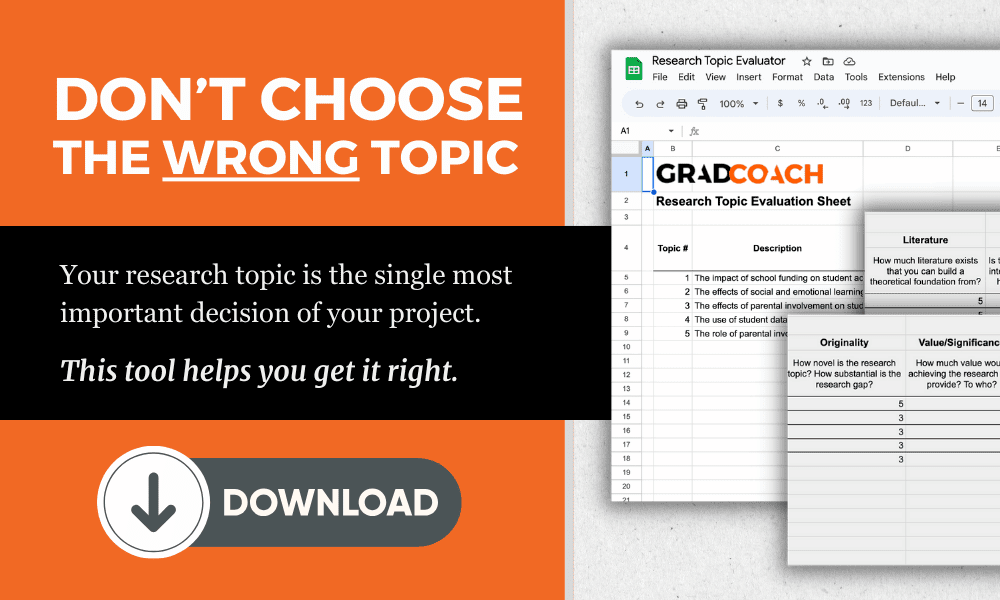How To Write A Research Proposal
A Straightforward How-To Guide + Free Template 📝
By: Derek Jansen (MBA) | Expert Reviewer: Dr. Eunice Rautenbach (DTech) | Updated March 2025

How To Write A Research Proposal
But first – what exactly is a proposal?
The research proposal is literally that: a written document that communicates what you propose to research, in a concise format. It’s where you put all that stuff that’s spinning around in your head down on to paper, in a logical, convincing fashion.
Convincing is the keyword here, as your research proposal needs to convince the assessor that your research is clearly articulated (i.e., a clear research question), worth doing (i.e., is unique and valuable enough to justify the effort), and doable within the restrictions you’ll face (time limits, budget, skill limits, etc.). If your proposal does not address these three criteria, your research won’t be approved, no matter how “exciting” the research idea might be.
PS – if you’re completely new to proposal writing, we’ve got a detailed walkthrough video covering two successful research proposals here.

How do I know I’m ready?
Before starting the writing process, you need to ask yourself 4 important questions. If you can’t answer them succinctly and confidently, you’re not ready – you need to go back and think more deeply about your dissertation topic.
You should be able to answer the following 4 questions before starting your dissertation or thesis research proposal:
- WHAT is my main research question? (the topic)
- WHO cares and why is this important? (the justification)
- WHAT data would I need to answer this question, and how will I analyse it? (the research design)
- HOW will I manage the completion of this research, within the given timelines? (project and risk management)
If you can’t answer these questions clearly and concisely, you’re not yet ready to write your research proposal – revisit our post on choosing a topic.
If you can, that’s great – it’s time to start writing up your dissertation proposal. Next, I’ll discuss what needs to go into your research proposal, and how to structure it all into an intuitive, convincing document with a linear narrative.
The 5 Essential Ingredients
Research proposals can vary in style between institutions and disciplines, but here I’ll share with you a handy 5-section structure you can use. These 5 sections directly address the core questions we spoke about earlier, ensuring that you present a convincing proposal. If your institution already provides a proposal template, there will likely be substantial overlap with this, so you’ll still get value from reading on.
For each section discussed below, make sure you use headers and sub-headers (ideally, numbered headers) to help the reader navigate through your document, and to support them when they need to revisit a previous section. Don’t just present an endless wall of text, paragraph after paragraph after paragraph…
Top Tip: Use MS Word Styles to format headings. This will allow you to be clear about whether a sub-heading is level 2, 3, or 4. Additionally, you can view your document in ‘outline view’ which will show you only your headings. This makes it much easier to check your structure, shift things around and make decisions about where a section needs to sit. You can also generate a 100% accurate table of contents using Word’s automatic functionality.
Ingredient #1 – Topic/Title Header
Your research proposal’s title should be your main research question in its simplest form, possibly with a sub-heading providing basic details on the specifics of the study. For example:
“Compliance with equality legislation in the charity sector: a study of the ‘reasonable adjustments’ made in three London care homes”
As you can see, this title provides a clear indication of what the research is about, in broad terms. It paints a high-level picture for the first-time reader, which gives them a taste of what to expect. Always aim for a clear, concise title. Don’t feel the need to capture every detail of your research in your title – your proposal will fill in the gaps.
Ingredient #2 – Introduction
In this section of your research proposal, you’ll expand on what you’ve communicated in the title, by providing a few paragraphs which offer more detail about your research topic. Importantly, the focus here is the topic – what will you research and why is that worth researching? This is not the place to discuss methodology, practicalities, etc. – you’ll do that later.
You should cover the following:
- An overview of the broad area you’ll be researching – introduce the reader to key concepts and language
- An explanation of the specific (narrower) area you’ll be focusing, and why you’ll be focusing there
- Your research aims and objectives
- Your research question(s) and sub-questions (if applicable)
Importantly, you should aim to use short sentences and plain language – don’t babble on with extensive jargon, acronyms and complex language. Assume that the reader is an intelligent layman – not a subject area specialist (even if they are). Remember that the best writing is writing that can be easily understood and digested. Keep it simple.

Note that some universities may want some extra bits and pieces in your introduction section. For example, personal development objectives, a structural outline, etc. Check your brief to see if there are any other details they expect in your proposal, and make sure you find a place for these.
Ingredient #3 – Scope
Next, you’ll need to specify what the scope of your research will be – this is also known as the delimitations. In other words, you need to make it clear what you will be covering and, more importantly, what you won’t be covering in your research. Simply put, this is about ring fencing your research topic so that you have a laser-sharp focus.
All too often, students feel the need to go broad and try to address as many issues as possible, in the interest of producing comprehensive research. Whilst this is admirable, it’s a mistake. By tightly refining your scope, you’ll enable yourself to go deep with your research, which is what you need to earn good marks. If your scope is too broad, you’re likely going to land up with superficial research (which won’t earn marks), so don’t be afraid to narrow things down.
Ingredient #4 – Literature Review
In this section of your research proposal, you need to provide a (relatively) brief discussion of the existing literature. Naturally, this will not be as comprehensive as the literature review in your actual dissertation, but it will lay the foundation for that. In fact, if you put in the effort at this stage, you’ll make your life a lot easier when it’s time to write your actual literature review chapter.
There are a few things you need to achieve in this section:
- Demonstrate that you’ve done your reading and are familiar with the current state of the research in your topic area.
- Show that there’s a clear gap for your specific research – i.e., show that your topic is sufficiently unique and will add value to the existing research.
- Show how the existing research has shaped your thinking regarding research design. For example, you might use scales or questionnaires from previous studies.
When you write up your literature review, keep these three objectives front of mind, especially number two (revealing the gap in the literature), so that your literature review has a clear purpose and direction. Everything you write should be contributing towards one (or more) of these objectives in some way. If it doesn’t, you need to ask yourself whether it’s truly needed.
Top Tip: Don’t fall into the trap of just describing the main pieces of literature, for example, “A says this, B says that, C also says that…” and so on. Merely describing the literature provides no value. Instead, you need to synthesise it, and use it to address the three objectives above.

Ingredient #5 – Research Methodology
Now that you’ve clearly explained both your intended research topic (in the introduction) and the existing research it will draw on (in the literature review section), it’s time to get practical and explain exactly how you’ll be carrying out your own research. In other words, your research methodology.
In this section, you’ll need to answer two critical questions:
- How will you design your research? I.e., what research methodology will you adopt, what will your sample be, how will you collect data, etc.
- Why have you chosen this design? I.e., why does this approach suit your specific research aims, objectives and questions?
In other words, this is not just about explaining WHAT you’ll be doing, it’s also about explaining WHY. In fact, the justification is the most important part, because that justification is how you demonstrate a good understanding of research design (which is what assessors want to see).
Some essential design choices you need to cover in your research proposal include:
- Your intended research philosophy (e.g., positivism, interpretivism or pragmatism)
- What methodological approach you’ll be taking (e.g., qualitative, quantitative or mixed)
- The details of your sample (e.g., sample size, who they are, who they represent, etc.)
- What data you plan to collect (i.e. data about what, in what form?)
- How you plan to collect it (e.g., surveys, interviews, focus groups, etc.)
- How you plan to analyse it (e.g., regression analysis, thematic analysis, etc.)
- Ethical adherence (i.e., does this research satisfy all ethical requirements of your institution, or does it need further approval?)
This list is not exhaustive – these are just some core attributes of research design. Check with your institution what level of detail they expect. The “research onion” by Saunders et al (2009) provides a good summary of the various design choices you ultimately need to make – you can read more about that here.
I didn’t know if I was good enough.
See how Kelsee went from lost and confused to conquering her PhD.Don’t forget the practicalities…
In addition to the technical aspects, you will need to address the practical side of the project. In other words, you need to explain what resources you’ll need (e.g., time, money, access to equipment or software, etc.) and how you intend to secure these resources. You need to show that your project is feasible, so any “make or break” type resources need to already be secured. The success or failure of your project cannot depend on some resource which you’re not yet sure you have access to.
Another part of the practicalities discussion is project and risk management. In other words, you need to show that you have a clear project plan to tackle your research with. Some key questions to address:
- What are the timelines for each phase of your project?
- Are the time allocations reasonable?
- What happens if something takes longer than anticipated (risk management)?
- What happens if you don’t get the response rate you expect?
A good way to demonstrate that you’ve thought this through is to include a Gantt chart and a risk register (in the appendix if word count is a problem). With these two tools, you can show that you’ve got a clear, feasible plan, and you’ve thought about and accounted for the potential risks.

Tip – Be honest about the potential difficulties – but show that you are anticipating solutions and workarounds. This is much more impressive to an assessor than an unrealistically optimistic proposal which does not anticipate any challenges whatsoever.
Let’s Recap: Research Proposal 101
And there you have it – how to write your dissertation or thesis research proposal, from the title page to the final proof. Here’s a quick recap of the key takeaways:
- The purpose of the research proposal is to convince – therefore, you need to make a clear, concise argument of why your research is both worth doing and doable.
- Make sure you can ask the critical what, who, and how questions of your research before you put pen to paper.
- Your research proposal should include (at least) 5 essential components:
- Title – provides the first taste of your research, in broad terms
- Introduction – explains what you’ll be researching in more detail
- Scope – explains the boundaries of your research
- Literature review – explains how your research fits into the existing research and why it’s unique and valuable
- Research methodology – explains and justifies how you will carry out your own research
Hopefully, this post has helped you better understand how to write up a winning research proposal. If you enjoyed it, be sure to check out the rest of the Grad Coach Blog. If your university doesn’t provide any template for your proposal, you might want to try out our free research proposal template.
Don't Stop Now - There's More ✨

Qualitative Research Basics: The 20,000-Foot View
New to qualitative? Learn about the four key phases of the qualitative research process: data collection, coding, analysis, and writing.

How To Choose The Right Qualitative Analysis Method
Not sure which qualitative analysis method to use? Learn how to choose the right method for your specific research project.

Reflexivity & Triangulation In Qualitative Research
Learn how reflexivity and triangulation help manage subjectivity in qualitative research by enhancing credibility and minimising bias.

Trustworthiness In Qualitative Research
Learn about the four pillars of trustworthiness in qualitative research: credibility, transferability, dependability, and confirmability.

How To Choose A Tutor For Your Dissertation
Hiring the right tutor for your dissertation or thesis can make the difference between passing and failing. Here’s what you need to consider.




Thank you so much for the valuable insight that you have given, especially on the research proposal. That is what I have managed to cover. I still need to go back to the other parts as I got disturbed while still listening to Derek’s audio on you-tube. I am inspired. I will definitely continue with Grad-coach guidance on You-tube.
Thanks for the kind words :). All the best with your proposal.
First of all, thanks a lot for making such a wonderful presentation. The video was really useful and gave me a very clear insight of how a research proposal has to be written. I shall try implementing these ideas in my RP.
Once again, I thank you for this content.
I found reading your outline on writing research proposal very beneficial. I wish there was a way of submitting my draft proposal to you guys for critiquing before I submit to the institution.
Hi Bonginkosi
Thank you for the kind words. Yes, we do provide a review service. The best starting point is to have a chat with one of our coaches here: https://gradcoach.com/book/new/.
Hello team GRADCOACH, may God bless you so much. I was totally green in research. Am so happy for your free superb tutorials and resources. Once again thank you so much Derek and his team.
You’re welcome, Erick. Good luck with your research proposal 🙂
thank you for the information. its precise and on point.
Really a remarkable piece of writing and great source of guidance for the researchers.
GOD BLESS YOU for your guidance.
Regards
Thanks so much for your guidance. It is easy and comprehensive the way you explain the steps for a winning research proposal.
Thank you guys so much for the rich post. I enjoyed and learn from every word in it. My problem now is how to get into your platform wherein I can always seek help on things related to my research work ?
Secondly, I wish to find out if there is a way I can send my tentative proposal to you guys for examination before I take to my supervisor
Once again thanks very much for the insights
Thanks for your kind words, Desire.
If you are based in a country where Grad Coach’s paid services are available, you can book a consultation by clicking the “Book” button in the top right.
Best of luck with your studies.
May God bless you team for the wonderful work you are doing,
If I have a topic, Can I submit it to you so that you can draft a proposal for me?? As I am expecting to go for masters degree in the near future.
Regards
Hi Adolph
Thanks for your comment. We definitely cannot draft a proposal for you, as that would constitute academic misconduct. The proposal needs to be your own work. We can coach you through the process, but it needs to be your own work and your own writing.
Best of luck with your research!
I found a lot of many essential concepts from your material. it is real a road map to write a research proposal.
so thanks a lot. If there is any update material on your hand on MBA please forward to me.
GradCoach is a professional website that presents support and helps for MBA student like me through the useful online information on the page and with my 1-on-1 online coaching with the amazing and professional PhD Kerryen.
Thank you Kerryen so much for the support and help 🙂
I really recommend dealing with such a reliable services provider like Gradcoah and a coach like Kerryen.
Hi,
Am happy for your service and effort to help students and researchers, Please, i have been given an assignment on research for strategic development, the task one is to formulate a research proposal to support the strategic development of a business area, my issue here is how to go about it, especially the topic or title and introduction.
Please, i would like to know if you could help me and how much is the charge.
Thank you.
This content is practical, valuable, and just great!
Thank you very much!
Hi Derek,
Thank you for the valuable presentation. It is very helpful especially for beginners like me. I am just starting my PhD.
This is quite instructive and research proposal made simple. Can I have a research proposal template?
Great!
Thanks for rescuing me, because I had no former knowledge in this topic.
But with this piece of information, I am now secured.
Thank you once more.
I enjoyed listening to your video on how to write a proposal. I think I will be able to write a winning proposal with your advice. I wish you were to be my supervisor.
Dear Derek Jansen,
Thank you for your great content. I couldn’t learn these topics in MBA, but now I learned from GradCoach. Really appreciate your efforts….
From Afghanistan!
I have got very essential inputs for startup of my dissertation proposal. Well organized properly communicated with video presentation. Thank you for the presentation.
Wow, this is absolutely amazing guys. Thank you so much for the fruitful presentation, you’ve made my research much easier.
this helps me a lot. thank you all so much for impacting in us. may god richly bless you all
How I wish I’d learn about Grad Coach earlier. I’ve been stumbling around writing and rewriting! Now I have concise clear directions on how to put this thing together. Thank you!
Fantastic!! Thank You for this very concise yet comprehensive guidance.
Even if I am poor in English I would like to thank you very much.
Thank you very much, this is very insightful.
Thank you very much, Sir. The way you pointed out the key domains to keep in mind while writing a research proposal is concrete and appropriate. A lot of things were buzzing in my mind, and I was not being able to jot down them sequentially. Your guidance helped me to write down a well structured research proposal.
I really enjoy and appreciate how simple and easy to understand your article is, i can’t wait to apply it. Thank you so much, it’s of great help to me.
This is awesome. Much appreciate